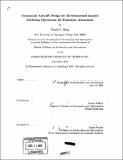| dc.contributor.advisor | Karen Willcox. | en_US |
| dc.contributor.author | King, Daniel J., S.M. Massachusetts Institute of Technology | en_US |
| dc.contributor.other | Massachusetts Institute of Technology. Dept. of Aeronautics and Astronautics. | en_US |
| dc.date.accessioned | 2006-09-28T15:10:30Z | |
| dc.date.available | 2006-09-28T15:10:30Z | |
| dc.date.copyright | 2005 | en_US |
| dc.date.issued | 2005 | en_US |
| dc.identifier.uri | http://hdl.handle.net/1721.1/34138 | |
| dc.description | Thesis (S.M.)--Massachusetts Institute of Technology, Dept. of Aeronautics and Astronautics, 2005. | en_US |
| dc.description | Includes bibliographical references (p. 121-123). | en_US |
| dc.description.abstract | Decisions that guide technology investment and policy-making for the future of air transportation will be based in part on the tradeoffs between environmental performance and economics. The Environmental Design Space (EDS) project explores the tradeoffs between noise, emissions, and economics for conceptual design of future aircraft. A key component to EDS is modeling the emissions of aircraft in operation. Traditional design tools need more detailed mission analysis to calculate operational emissions in the landing and takeoff cycle (LTO), and in cruise. This thesis presents a methodology for modeling an aircraft flight profile and the corresponding aircraft and engine states required to calculate emissions over that mission. The methodology was implemented as an operations model in EDS. The development of the methodology and demonstrations of the model are presented in this thesis. The model takes user-input flight procedures, including mission range, and uses aerodynamic models and engine models from EDS to calculate flight profiles. The operations model can be used for analyzing the relationships between flight procedures, and emissions and fuel burn for a fixed design. Alternatively, multidisciplinary design optimization (MDO) with EDS and the operations model can be used to optimize the aircraft design for minimized emissions in the flight profile. | en_US |
| dc.description.abstract | (cont.) MDO with the new model enables exploration of a design space that includes operations along with design in evaluating tradeoffs between emissions, noise, and economics. In addition to the development and demonstration of the operations model, a detailed study of the effects of derated-thrust takeoffs on emissions and fuel burn for Boeing 777 flights is presented in this thesis. The emissions of airline flights are calculated from flight data and compared to International Civil Aviation Organization (ICAO) assumptions for the engines used. The results show that NOx emissions are significantly less than the ICAO assumed values for takeoff and climb-out. A second analysis compares the emissions of derated thrust; takeoffs to the emissions that would have resulted if the same aircraft had flown with full-power on the same day. The results show a relationship between percent derate and a change in the emissions produced in takeoff, and a tradeoff of increased fuel burn for a decrease in NOx production. | en_US |
| dc.description.statementofresponsibility | by Daniel J. King. | en_US |
| dc.format.extent | 123 p. | en_US |
| dc.format.extent | 7388754 bytes | |
| dc.format.extent | 7393873 bytes | |
| dc.format.mimetype | application/pdf | |
| dc.format.mimetype | application/pdf | |
| dc.language.iso | eng | en_US |
| dc.publisher | Massachusetts Institute of Technology | en_US |
| dc.rights | M.I.T. theses are protected by copyright. They may be viewed from this source for any purpose, but reproduction or distribution in any format is prohibited without written permission. See provided URL for inquiries about permission. | en_US |
| dc.rights.uri | http://dspace.mit.edu/handle/1721.1/7582 | |
| dc.subject | Aeronautics and Astronautics. | en_US |
| dc.title | Conceptual aircraft design for environmental impact : modeling operations for emissions assessment | en_US |
| dc.type | Thesis | en_US |
| dc.description.degree | S.M. | en_US |
| dc.contributor.department | Massachusetts Institute of Technology. Department of Aeronautics and Astronautics | |
| dc.identifier.oclc | 67837001 | en_US |
